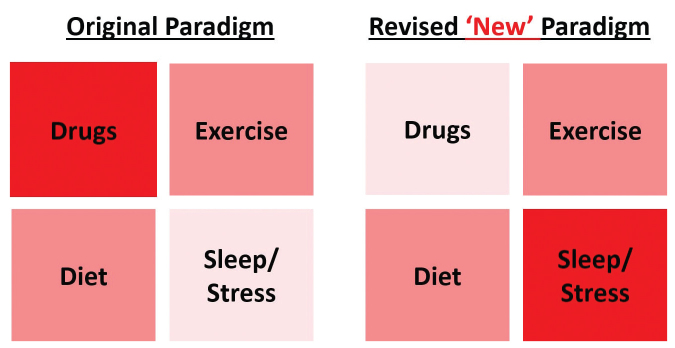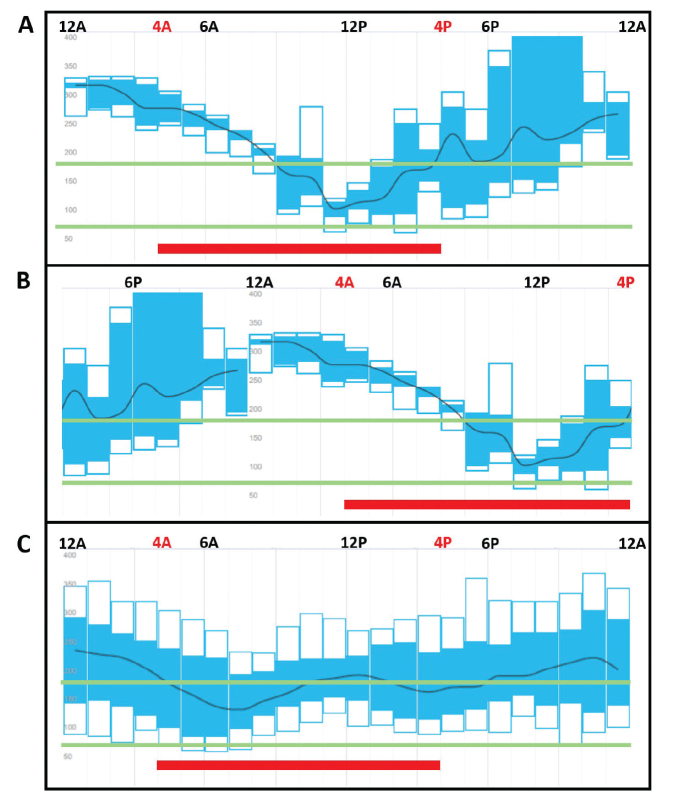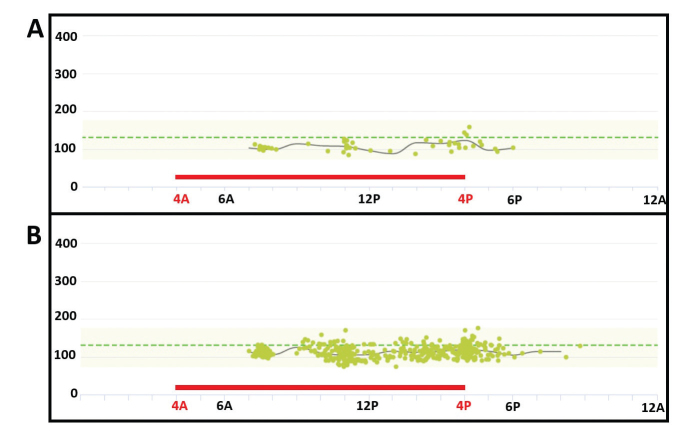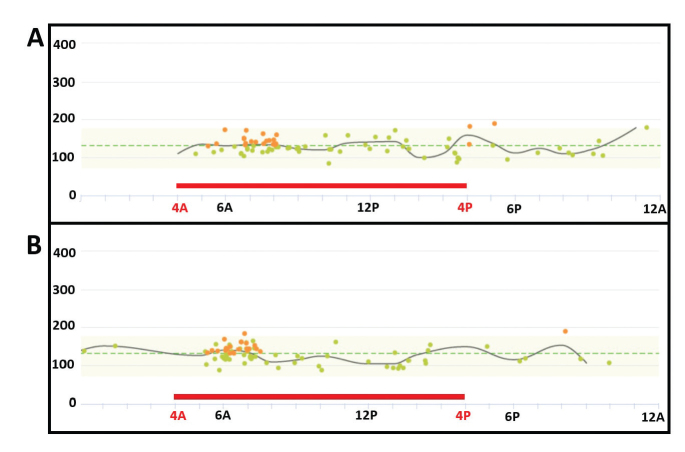The 2017 Nobel Prize in Physiology and Medicine, awarded jointly to Jeffrey C. Hall, Michael Rosbash, and Michael W. Young for their discoveries of molecular mechanisms controlling the circadian rhythm, offered the opportunity to reflect on how clockwork mechanisms in the body affect the management of diabetes (1).
Circadian rhythmicity relates to all cells in the human body and to the microbiome that coexists within its confines (2,3). Clock genes control intracellular metabolic processes, whereas tissue activity in aggregate is responsive to central clock rhythms entrained by circadian light/dark cycles (Figure 1) (2,3). The circadian system regulates energy homeostasis for the body and is vulnerable to disruption through aberrant feeding/fasting cycles (2,4). Metabolic dysfunction induced by such chrono-disruptive feeding behavior may be corrected by time-restricted feeding in synchronicity with our master resident pacemaker in the suprachiasmatic nucleus of the hypothalamus responsive to immutable celestial cues (2,5–7).
FIGURE 1.
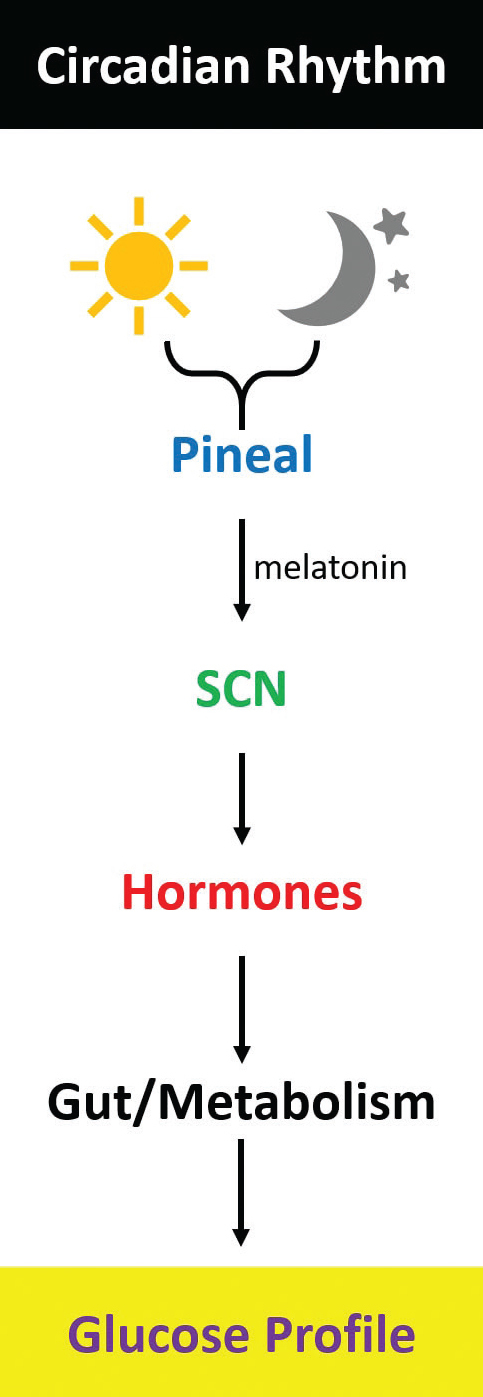
The relationship of environmental (light and dark) cues with the central pacemaker and its effects on the periphery. SCN, suprachiasmatic nuclei.
The liver is the central organ involved in nutrient processing and energy metabolism (7,8). It receives amino acids, monosaccharides, and free fatty acids from the gut, along with other trace elements and vitamins, and proceeds to discharge its duties, fabricating tissue and generating energy (7). This process is regulated by hormonal and neurological cues from other organs, most importantly the pancreas, adrenal glands, and gut, and is very much dependent on appropriate timing (3,7,9). Feeding not entrained to innate circadian rhythmicity results in metabolic aberrations and gut dysfunction (3,10,11).
Metabolic aberrations are most frequently expressed as supraphysiologic glucose and triglyceride levels (3,7,10). These affect many organs and, importantly, contribute to anatomic changes in the liver, where inappropriate energy storage preponderates in the form of fatty infiltration (12).
Gut dysfunction relates to motility issues and microbiome disruption, resulting in maldigestion (13,14). The gut, with its trillions of resident microbes, is in constant communication regarding the size and composition of meals with organs throughout the body via hormonal and neuronal pathways (4). Digestive hyperactivity during rest alarms the organism at a time when restorative mechanisms are due to be operational as dictated by the sleep cycle.
The importance of time-restricted feeding for metabolic health was highlighted by early observations on the diurnal variation in oral glucose tolerance favoring the morning meal (15). Many more studies have since shown that circadian rhythmicity influences all aspects of digestion, including gastric pH, hepatic and renal blood flow, serum hormone levels (e.g., insulin and cortisol), and liver enzyme activity. These observations have served to establish the nascent field of chrono-pharmacology. More importantly, they have permitted us to appreciate the effects of nutrient input on the activity-rest cycle.
Nutrient sensing drives several peripheral clocks, including the liver, and may disrupt synchronization with the central pacemaker (16,17). Such circadian misalignment, driven by artificial light and nighttime work (16), has long-term implications expressed as impaired glucose tolerance, hyperlipidemia, weight gain, and hypertension, which we have come to collectively characterize as the metabolic syndrome. Re-entraining the peripheral clocks is now being recognized as the province of a new field in personalized medicine, namely that of “chrononutrition.” As such, the timing of meals is equally as important as their quality and quantity for health maintenance and longevity.
Our observations emphasize the importance of chrononutrition in people with diabetes because even insulin sensitivity has been shown to exhibit circadian rhythmicity (7). Glycemic responses to meals are exaggerated in these individuals, more so when the meal is timed to be consumed out of sync with the metabolic pacemaker (18). Accordingly, we now recognize optimal hormonal and hepatic function beginning in the early morning (4:00 a.m.) and fading in the early evening (4:00 p.m.) (Figures 2 and 3) (7). Review of glucose records—increasingly more abundant in the era of continuous glucose monitoring (CGM), which permits review of several months of detailed glucose profiling and follow-up care—confirms that evening lifestyle defines morning glycemia, thus setting the stage for the day’s profile. Late-night feeding and night-shift work introduce a “jet-lag” experience, which, when sustained, virtually guarantees metabolic dysregulation.
FIGURE 2.
Proposed paradigm shift in diabetes management redirecting focus to the rest period exemplified by the “stress-sleep” pillar. Patients and providers appreciate this concept by reviewing glycemic profiles as 4:00 p.m. to 4:00 p.m. depictions, as opposed to midnight-to-midnight. This graphic modification emphasizes the defining role of dinner in determining the next day’s fasting (morning) glucose level.
FIGURE 3.
Novel presentation of glucose data from a patient with type 1 diabetes. The CGM data reflect on the liver (gut/pacemaker) activity (indicated with a red bar). The shaded blue area represents the 25th–75th percentile of glucose results. Panel A is a standard modal day CGM depiction from midnight to midnight that does not highlight the relationship of dinner to morning fasting blood glucose. Panel B showcases a modified CGM report depicting data from 4:00 p.m. to 4:00 p.m. and clearly demonstrating the effects of dinner on morning glycemia. Panel C illustrates the glycemic benefit of lifestyle modification when redistributing dinner calories in favor of breakfast and lunch.
We have delivered this message to our patients consistently for many years, and more urgently now as CGM has served to underscore the level of control individuals have over their level of morning glycemia and, by extension, over the mean amplitude of their glycemic excursions (MAGE) throughout the day (19). This control is independent of any diabetes medication regimen.
Patient cases presented here in graphic form are representative of results obtained from our patients with diabetes (n = 243) using profiling of glucose meter results with Glooko (Glooko, Mountain View, Calif.) and/or CGM records using the Freestyle Libre Pro (Abbott, Alameda, Calif.) and Dexcom G4/G5 systems (Dexcom, San Diego, Calif.) in the past 2 years.
The patient whose glucose data are depicted in Figure 3 presented with type 1 diabetes. Panel A, a standard modal day CGM data report from midnight to midnight, does not highlight the relationship of dinner to the morning (fasting) blood glucose. Panel B showcases a modified CGM depiction conforming to the new 4:00 a.m.-to-4:00 p.m. time-restricted feeding paradigm and clearly demonstrates the effects of dinner on morning glycemia. Panel C illustrates the glycemic benefit of lifestyle modification when redistributing dinner calories in favor of breakfast and lunch.
The CGM results shown in Figure 3 are representative of an aggregate of recordings over several days. Panel A and panel B (with the same data displayed in a different time format) are the product of 633 readings over 4 days. Panel C, from the same patient, presents 7,602 results over 29 days, after lifestyle change (i.e., time-restricted feeding). As can be seen, dinner restriction dampened the MAGE.
In a paradigm of trial and error, patients understand that restricting the (caloric) size of the evening meal, and more importantly, timing it close to the 4:00 p.m. cut-off time while favoring breakfast and lunch, results in improved fasting blood glucose, frequently necessitating reduction of medication doses (10,14). Alternatively, attempts to restore morning euglycemia with increasing doses of insulin, frequently based on counting ill-timed carbohydrate deliveries, results in hypoglycemia. Patients appreciate that redistributing calories in this manner permits them to enjoy a wide variety of foods while maintaining weight control and improving diabetes control without increasing medication requirements. With simple adherence to the new paradigm, glycemic control without medication becomes feasible (Figures 4 and 5).
FIGURE 4.
Glucose data from a patient with type 2 diabetes. In Panel A, the patient is on insulin with conventional meal plan emphasizing (late) dinner. Panel B shows that implementing the new feeding paradigm (4:00 a.m. to 4:00 p.m.) permitted the patient to maintain euglycemia while off insulin. The red bars mark the circadian rhythm for liver (gut/pacemaker) activity.
FIGURE 5.
Glucose data from a second patient with type 2 diabetes. In Panel A, the patient is on insulin and oral agents with a conventional meal plan emphasizing (late) dinner. Panel B shows that implementing the new paradigm (feeding from 4:00 a.m. to 4:00 p.m.) permitted the patient to maintain euglycemia with diet alone. The red bars mark the circadian rhythm for liver (gut/pacemaker) activity.
The patient whose data are depicted in Figure 4 has type 2 diabetes. In Panel A, the patient was on insulin with conventional meal plan emphasizing (late) dinner. Implementing the new 4:00 a.m. to 4:00 p.m. time-restricted feeding paradigm allowed the patient to maintain euglycemia off insulin, as shown in Panel B. This patient’s average fasting glucose before implementing the new guidelines was 103 mg/dL (25th–75th percentile 99–105 mg/dL) while on medication, including insulin. After implementing the new approach to meal timing, her average fasting glucose fasting was 112 mg/dL (25th–75th percentile 107–117 mg/dL) off of all medications.
Figure 5 provides similar depictions of glucose data from another patient with type 2 diabetes. This patient’s average fasting glucose before the meal timing restriction was 132 mg/dL (25th–75th percentile 119–143 mg/dL) while on medication. After implementing the new meal timing paradigm, the patient’s fasting glucose was 136 mg/dL (25th–75th percentile 123–144 mg/dL) without any diabetes medication.
Patients who modified their lifestyle to approximate the 4 a.m. to 4:00 p.m. feeding paradigm were the most successful in losing weight and improving their glycemic profile, with fewer medications. In all 243 patients providing records, the relationship of high fasting values with late meal times was evident.
Our intention in this article is to alert practitioners to the defining benefit of early meal times in achieving euglycemia. Insulin resistance can now be understood as a protective mechanism in an era of energy surfeit with inopportune deliveries. The liver, when challenged during its gut clock–dictated rest phase, stores and regurgitates rather than processes nutrients intended for energy needs and tissue growth and restoration (7,14). The benefits of fasting have been extolled, but the importance of timed fasting, according to gut clock dictates, remains to be reaffirmed and reintroduced to our lifestyle. The alternative, offered by polypharmacy, is both self-defeating and financially untenable for society (20).
Duality of Interest
No potential conflicts of interest relevant to this article were reported.
Author Contributions
N.H.E.M. wrote the manuscript, and V.B. researched the data and created the figures. Both authors reviewed and edited the manuscript. N.H.E.M. is the guarantor of this work and, as such, had full access to all the data in the study and takes responsibility for the integrity of the data and the accuracy of the data analysis.
References
- 1.Nobelprize.org The Nobel Assembly at Karolinska Institutet has today decided to award the 2017 Nobel Prize in Physiology or Medicine jointly to Jeffrey C. Hall, Michael Rosbash and Michael W. Young for their discoveries of molecular mechanisms controlling the circadian rhythm. Available from www.nobelprize.org/nobel_prizes/medicine/laureates/2017/press.html. Accessed 4 March 2018
- 2.Wang Y, Kuang Z, Yu X, Ruhn KA, Kubo M, Hooper LV. The intestinal microbiota regulates body composition through NFIL3 and the circadian clock. Science 2017;357:912–916 [DOI] [PMC free article] [PubMed] [Google Scholar]
- 3.Colwell CS. Circadian Medicine. New York, John Wiley & Sons, 2015 [Google Scholar]
- 4.Johnson CH, Zhao C, Xu Y, Mori T. Timing the day: what makes bacterial clocks tick? Nat Rev Microbiol 2017;15:232–242 [DOI] [PMC free article] [PubMed] [Google Scholar]
- 5.Rusak B, Robertson HA, Wisden W, Hunt SP. Light pulses that shift rhythms induce gene expression in the suprachiasmatic nucleus. Science 1990;248:1237–1240 [DOI] [PubMed] [Google Scholar]
- 6.Mattson MP, Allison DB, Fontana L, et al. . Meal frequency and timing in health and disease. Proc Natl Acad Sci U S A 2014;111:16647–16653 [DOI] [PMC free article] [PubMed] [Google Scholar]
- 7.Zarrinpar A, Chaix A, Panda S. Daily eating patterns and their impact on health and disease. Trends Endocrinol Metab 2016;27:69–83 [DOI] [PMC free article] [PubMed] [Google Scholar]
- 8.Hall JE. Guyton and Hall Textbook of Medical Physiology. 12th ed. Philadelphia, Pa, Saunders Elsevier, 2011 [Google Scholar]
- 9.Zhou D, Wang Y, Chen L, et al. . Evolving roles of circadian rhythms in liver homeostasis and pathology. Oncotarget 2016;7:8625–8639 [DOI] [PMC free article] [PubMed] [Google Scholar]
- 10.Jakubowicz D, Barnea M, Wainstein J, Froy O. High caloric intake at breakfast vs. dinner differentially influences weight loss of overweight and obese women: effect of high-calorie breakfast vs. dinner. Obesity 2013;21:2504–2512 [DOI] [PubMed] [Google Scholar]
- 11.Barkin SL, Heerman WJ, Warren MD, Rennhoff C. Millennials and the world of work: the impact of obesity on health and productivity. J Bus Psychol 2010;25:239–245 [DOI] [PMC free article] [PubMed] [Google Scholar]
- 12.Park Y-W, Zhu S, Palaniappan L. The metabolic syndrome prevalence and associated risk factor findings in the US population from the Third National Health and Nutrition Examination Survey, 1988–1994. JAMA Intern Med 2003;163:427–436 [DOI] [PMC free article] [PubMed] [Google Scholar]
- 13.Halpin AL, de Man TJB, Kraft CS, et al. . Intestinal microbiome disruption in patients in a long-term acute care hospital: a case for development of microbiome disruption indices to improve infection prevention. Am J Infect Control 2016;44:830–836 [DOI] [PMC free article] [PubMed] [Google Scholar]
- 14.Oike H, Oishi K, Kobori M. Nutrients, clock genes, and chrononutrition. Curr Nutr Rep 2014;3:204–212 [DOI] [PMC free article] [PubMed] [Google Scholar]
- 15.Jarrett RJ, Baker IA, Keen H, Oakley NW. Diurnal variation in oral glucose tolerance: blood sugar and plasma insulin levels morning, afternoon, and evening. BMJ 1972;1:199–201 [DOI] [PMC free article] [PubMed] [Google Scholar]
- 16.Ribas-Latre A, Eckel-Mahan K. Interdependence of nutrient metabolism and the circadian clock system: importance for metabolic health. Mol Metab 2016;5:133–152 [DOI] [PMC free article] [PubMed] [Google Scholar]
- 17.Ferrell JM, Chiang JYL. Circadian rhythms in liver metabolism and disease. Acta Pharm Sin B 2015;5:113–122 [DOI] [PMC free article] [PubMed] [Google Scholar]
- 18.Monnier L, Lapinski H, Colette C. Contributions of fasting and postprandial plasma glucose increments to the overall diurnal hyperglycemia of type 2 diabetic patients: variations with increasing levels of HbA1c. Diabetes Care 2003;26:881–885 [DOI] [PubMed] [Google Scholar]
- 19.Service FJ, Molnar GD, Rosevear JW, Ackerman E, Gatewood LC, Taylor WF. Mean amplitude of glycemic excursions, a measure of diabetic instability. Diabetes 1970;19:644–655 [DOI] [PubMed] [Google Scholar]
- 20.Kojima G, Bell C, Tamura B, et al. . Reducing cost by reducing polypharmacy: the Polypharmacy Outcomes Project. Am J Med Dir Assoc 2012;13:818e11–e15 [DOI] [PMC free article] [PubMed] [Google Scholar]



